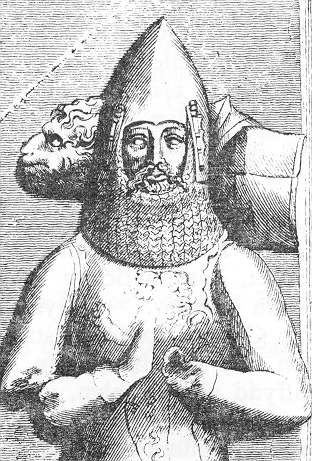
Rhys ap Gruffydd or ap Gruffudd was the ruler of the kingdom of Deheubarth in south Wales from 1155 to 1197. Today, he is commonly known as The Lord Rhys, in Welsh Yr Arglwydd Rhys, although this title may have not been used in his lifetime. He usually used the title "Proprietary Prince of Deheubarth" or "Prince of South Wales", but two documents have been discovered in which he uses the title "Prince of Wales" or "Prince of the Welsh". Rhys was one of the most successful and powerful Welsh princes, and, after the death of Owain Gwynedd of Gwynedd in 1170, the dominant power in Wales.
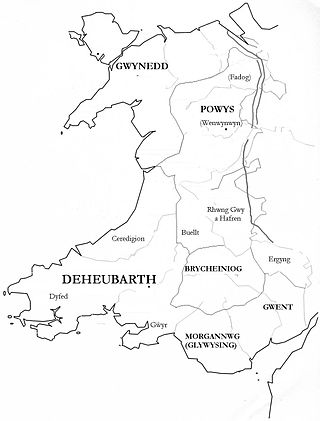
Deheubarth was a regional name for the realms of south Wales, particularly as opposed to Gwynedd. It is now used as a shorthand for the various realms united under the House of Dinefwr, but that Deheubarth itself was not considered a proper kingdom on the model of Gwynedd, Powys, or Dyfed is shown by its rendering in Latin as dextralis pars or as Britonnes dexterales and not as a named land. In the oldest British writers, Deheubarth was used for all of modern Wales to distinguish it from Hen Ogledd, the northern lands whence Cunedda originated.

Nest ferch Rhys was the daughter of Rhys ap Tewdwr, last King of Deheubarth in Wales, by his wife, Gwladys ferch Rhiwallon ap Cynfyn of Powys. Her family is of the House of Dinefwr. Nest was the wife of Gerald de Windsor, Constable of Pembroke Castle and son of the Constable of Windsor Castle in Berkshire, by whom she was the ancestress of the FitzGerald dynasty.

Rhys ap Tewdwr was a king of Deheubarth in Wales and member of the Dinefwr dynasty, a branch descended from Rhodri the Great. Following the Norman Conquest, he had to pay William the Conqueror to keep his kingdom, which lasted until the end of William's reign.
Maelgwn ap Rhys was prince of part of the kingdom of Deheubarth in south west Wales.
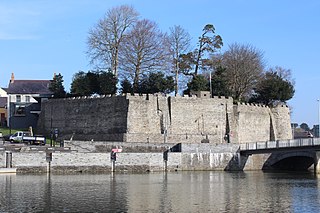
Cardigan Castle is a castle overlooking the River Teifi in Cardigan, Ceredigion, Wales. It is a Grade I listed building. The castle dates from the late 11th-century, though was rebuilt in 1244. Castle Green House was built inside the castle walls in the early 1800s. After falling into disrepair the castle was restored in the early 2000s and opened to the public in 2015. It is owned by Ceredigion County Council and now includes a heritage centre and open-air concert facilities. The castle's gardens are listed on the Cadw/ICOMOS Register of Parks and Gardens of Special Historic Interest in Wales.
Gwenllian ferch Gruffydd was a 12th century Welsh rebel and Princess consort of Deheubarth. The daughter of Prince of Gwynedd Gruffudd ap Cynan and member of the House of Aberffraw, she married Gruffydd ap Rhys, the Prince of Deheubarth, and would lead a "patriotic revolt" with him during the Great Revolt of 1136 until her death at the battle at Kidwelly Castle.

Owain ap Cadwgan was a prince of Powys in eastern Wales. He is best known for his abduction of Nest, wife of Gerald of Windsor. Owain was the eldest son of Cadwgan ap Bleddyn, prince of part of Powys. He is first recorded in 1106, when he killed Meurig and Griffri, the sons of Trahaearn ap Caradog, who held lands in Arwystli.

Wiston Castle is a motte and bailey castle in the Pembrokeshire village of Wiston in south west Wales and is one of the best examples of its type in Wales. The castle and village were founded by Wizo, a Flemish settler who was granted the land by Henry I of England after he had wrested control from the previous owner, Arnulf de Montgomery. The castle was captured by the Welsh on several occasions but on each occasion it was retaken. It was abandoned during the thirteenth century when the then owner moved to nearby Picton Castle.
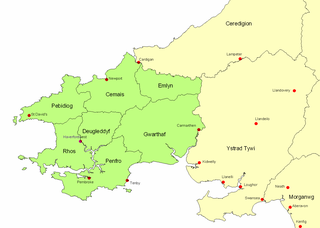
The Kingdom of Dyfed, one of several Welsh petty kingdoms that emerged in 5th-century sub-Roman Britain in southwest Wales, was based on the former territory of the Demetae. The medieval Irish narrative The Expulsion of the Déisi attributes the kingdom's founding to Eochaid, son of Artchorp, who was forced across the Irish sea in the 5th century; his descendants founded the line of the kings of Dyfed down to "Tualodor mac Rígin". The Normans invaded Wales, and by 1138 incorporated Dyfed into a new shire called Pembrokeshire after the Norman castle built in the Cantref of Penfro and under the rule of the Marcher Earl of Pembroke.
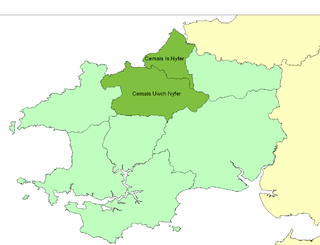
Cemais was an ancient cantref of the Kingdom of Dyfed, from the 11th century a Norman Marcher Lordship, from the 16th century a Hundred, and is now part of Pembrokeshire, Wales. It occupied the coastal area between the Teifi estuary and Fishguard, and the northern and southern slopes of the Preseli Hills, covering an area of approximately 140 square miles (360 km2). The Afon Nyfer divided it into two commotes: Cemais Is Nyfer to the north and Cemais Uwch Nyfer to the south.
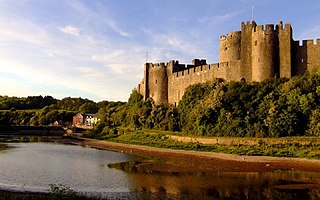
Gerald de Windsor, aliasGerald FitzWalter, was an Cymro-Norman lord who was the first Castellan of Pembroke Castle in Pembrokeshire. Son of the first Norman-French Constable of Windsor Castle, and married to a Welsh Princess daughter of the King of Deheubarth, he was in charge of the Norman forces in south-west Wales. He was also steward and governor for the Norman magnate Arnulf de Montgomery. His descendants were the FitzGerald dynasty, as well as the FitzMaurice, De Barry, and Keating dynasties of Ireland, who were elevated to the Peerage of Ireland in the 14th century. He was also the ancestor of the prominent Carew family, of Moulsford in Berkshire, the owners of Carew Castle in Pembrokeshire and of Mohuns Ottery in Devon.
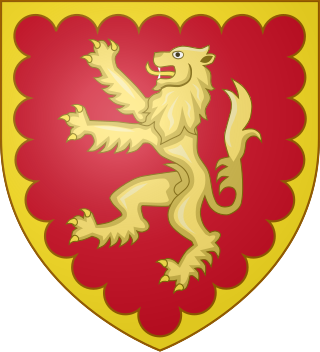
The Royal House of Dinefwr was a cadet branch of the Royal House of Gwynedd, founded by King Cadell ap Rhodri, son of Rhodri the Great. Their ancestor, Cunedda Wledig, born in late Roman Britain, was a Sub-Roman warlord who founded the Kingdom of Gwynedd during the 5th century, following the Anglo-Saxon settlement of Britain. As Celtic Britons, the House of Dinefwr was ruling before the Norman conquest, having to fight with their neighbors such as the Celtics, Anglo-Saxons and Vikings, before struggling with the Normans afterwards. Many members of this family were influential in Welsh history, such as Hywel Dda, who codified Welsh law under his rule, and achieved the important title of King of the Britons, or Lord Rhys, Prince of Wales, who rebelled against Richard the Lionheart, and became one of the most powerful Welsh leaders of the Middle Ages.
This article is about the particular significance of the century 1201–1300 to Wales and its people.
This article is about the particular significance of the century 1101–1200 to Wales and its people.

Elfael was one of a number of Welsh cantrefi occupying the region between the River Wye and river Severn, known as Rhwng Gwy a Hafren, in the early Middle Ages. It was divided into two commotes, Is Mynydd and Uwch Mynydd, separated by the chain of hills above Aberedw. In the late medieval period, it was a marcher lordship. However, after the Laws in Wales Act 1535, it was one of the territorial units which went to make up the county of Radnorshire in 1536.

The history of Gwynedd in the High Middle Ages is a period in the History of Wales spanning the 11th through the 13th centuries. Gwynedd, located in the north of Wales, eventually became the most dominant of Welsh polities during this period. Contact with continental courts allowed for Gwynedd to transition from a petty kingdom into an increasingly sophisticated principality of seasoned courtiers capable of high level deplomacy and representation; not only with the Angevine kings, but also the king of France and the Papal See. Distinctive achievements in Gwynedd include further development of Medieval Welsh literature, particularly poets known as the Beirdd y Tywysogion associated with the court of Gwynedd; the reformation of bardic schools; and the continued development of Cyfraith Hywel. All three of these further contributed to the development of a Welsh national identity in the face of Anglo-Norman encroachment of Wales.
Angharad ferch Llywelyn was a daughter of Llywelyn ab Iorwerth, Prince of Wales. The identity of her mother is uncertain; but several later genealogical sources, including Pedigrees of Some Of the Emperor Charlemagne's Descendants, Volume III, compiled by J. Orton Buck and Timothy Field Beard, give Llywelyn's consort Joan, daughter of King John of England, as her mother.
The Lordship of Brecknock was an Anglo-Norman marcher lordship located in southern central Wales.












